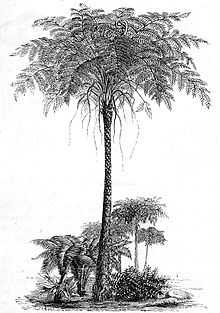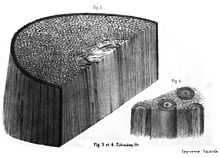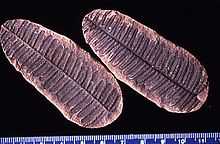Psaronius
| Psaronius Temporal range: Late Carboniferous–Permian | |
|---|---|
| | |
| A transverse section through a Psaronius stem. ~12cm across. | |
| | |
| An equivalent section through a modern tree fern. ~6cm across. | |
| Scientific classification | |
| Kingdom: | Plantae |
| Division: | Pteridophyta |
| Class: | Marattiopsida |
| Order: | Marattiales |
| Family: | Psaroniaceae |
| Genus: | Psaronius |
Psaronius was a Marattialean tree fern which grew to 10m in height, and is associated with leaves of the organ genus Pecopteris and other extinct tree ferns. Originally, Psaronius was a name for the petrified stems, but today the genus is used for the entire tree fern. Psaronius tree fern fossils are found from the Carboniferous through the Permian. [1]

Etymology
The word Psaronius comes from the Greek ψαρονιος (psaronius, precious stone) the root of which is ψαρον (psaron, a starling bird.] The stone was used for ornamental purposes in Europe and acquired the name for its resemblance to the speckled pattern of the starling. In Germany, the stone was called staarstein. And in English, it was called either starry-stone or starling stone.[2]
Description
Like many extinct trees, psaronius is known by various individual fossil parts that are not always found together. The main parts include: the root mantle, the stem, the fronds, the coziers (fiddleheads), and leaves with spores.

Root Mantle
An unusual feature is that Psaronius did not have a true trunk, but had a massive root mantle formed by hundreds of rootlets. These rootlets are referred to as adventitious because they are appearing in an atypical location. These adventitious roots originate in a central stem high in the tree. This central stem becomes smaller lower in the tree so that at the base the mantle is comprised entirely of roots. In some specimens, this mantle is over 1.0 m in diameter at the base of the tree. The fossilized wood of this root mantle is simply referred to as Psaronius. The side impressions of these adventitious roots are referred to as Tubiculites by the French Geologist François Cyrille Grand'Eury in 1877.[3]
An Ecosystem in the Psaronius Root Mantle
Like modern tree ferns, Psaronius included other plant species growing in the root mantle. It has been determined through cross-sections of petrified Psaronius, that various vining and epiphytic plants were growing within the tree fern. Some Carboniferous plant species are only known from their fossilized remains within these root mantles. Some of these that have been studied extensively are the epiphyte Botryopteris, the vining climber Ankyropteris and the small climbing ferns called Tubicaulis.[4] [5]
Fronds and Leaves
The leaves most often associated with Psaronius are those known as Pecopteris, but some species of Psaronius bore Sphenopteris foliage. Fossil of the croziers (or fiddleheads) of the fern fronds have been found. They sometimes go by the name Spiropteris. The study of croziers associated with psaronius wood have been used to determine foliage associations. The fronds were often bipinnate and sometimes tripinnate. Other leaf taxon associated with Psaronius include: Asterotheca, Acitheca, Remia and Radstockia.[1]
-

Pecopteris polymorpha
-

Pecopteris arborescens
-

Pecopteris villosa
Leaf Scar
The bases where the leaves attached were thick to carry the weight of fronds that could attain the size of 2 to 3 meters. stem scars. When fronds abscised from Psaronius, they left elliptical scars on the surface of the stem. Fossils of these leaf scars appear in different arrangements which may indicate different species of trees. These scars are known as Caulopteris, Megaphyton, Hagiophyton, and Artisophyton based on the four main arrangement patterns.[1][6]
-

Psaronius stem surface petiole base configurations. A. Caulopteris . B. Megaphyton . C. Hagiophyton . D. Artisophyton
Relationship to modern ferns
Psaronius is in included in the fern family Marattiaceae. Living representatives of this family include many large ferns but none are a 'tree form' like Psaronius. Recent molecular studies indicate that this group of ferns have a very old lineage and may be a sister group to the horsetails Equisetum. Modern tree ferns have many similarities to Psaronius but are in a younger fern family, the Cyatheales.
References
- ↑ 1.0 1.1 1.2 Taylor, Thomas N; Taylor, Edith L; Krings, Michael (2009). Paleobotany: The biology and evolution of fossil plants. ISBN 978-0-12-373972-8.
- ↑ Whitney, W.D. (1906). The Century Dictionary and Cyclopedia. Century Company. p. 4813.
- ↑ Grand'Eury, François Cyrille (1877). Mémoire sur la flore carbonifère du département de la Loire et du centre de la France: étudiée aux trois points de vue, botanique, stratigraphique et géognostique. Imprimerie nationale. p. 98,102.
- ↑ Rößler, Ronny (2000). "The late Palaeozoic tree fern Psaronius — an ecosystem unto itself". Review of Palaeobotany and Palynology 108: 55–74. doi:10.1016/s0034-6667(99)00033-0.
- ↑ DiMichele, William A.; Phillips, Tom L. (2002). "The ecology of Paleozoic ferns" (PDF). Review of Palaeobotany and Palynology 119: 143–159. doi:10.1016/s0034-6667(01)00134-8.
- ↑ Pfefferkorn, H. W. (1976). "Pennsylvanian tree fern compressions Caulopteris , Megaphyton , and Artisophyton". Illinois State Geological Survey Circular 492: 1–31. doi:10.5962/bhl.title.61459.
External links
- http://www.xs4all.nl/~steurh/engpsar/epsaron.html
- http://botany.cz/en/psaronius/
- http://www.georgesbasement.com/LesquereuxAtlasP/Stemmatopteris-to-Psaronius-Lesquereux.htm
| Wikimedia Commons has media related to Psaronius. |